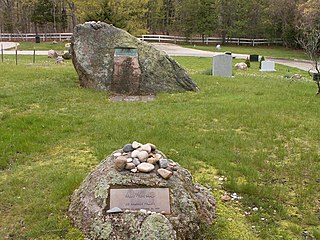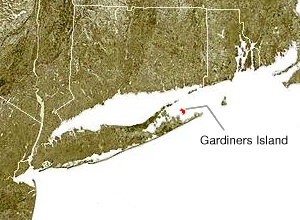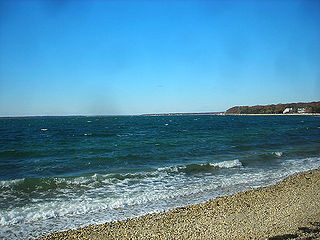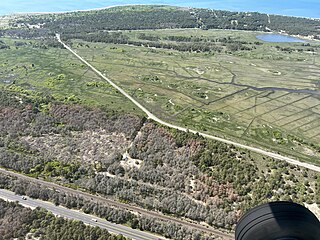History
The name traditionally refers to the working class families who live in an area called Springs (never, in local parlance, "the Springs") in the north of East Hampton, New York, though for several decades it has been used to refer to residents of East Hampton as a whole. Many of the original Bonac families in Springs were among the very early settlers of the town having come from England, possibly Kent or Dorchester, Dorset, in the 17th and 18th centuries.
The family names associated for generations with the term "Bonacker" include Miller, King, Bennett, Conklin, Strong, Havens, and Lester. The term Bonacker comes from Accabonac Harbor, which in turn derives its name from Montaukett/Algonquian languages term for "root place," or "place of ground nuts" (in most interpretations referring to potatoes). [1]
For some three hundred years, Bonackers made their living as baymen, fishermen, and farmers. Clams and clamming—both hardshell and softshell—were at the heart of Bonac culture and cuisine. Bonac specialties include clam pie, clam fritters, oysters, clam chowder (traditionally, never made with milk, but with tomatoes), bluefish, porgies, blowfish, eel, and blue crabs. The "bay" referred to in relation to a Bonac bayman was Gardiner's Bay, the shoal bay just east of Springs (now often mistakenly called Napeague Bay, a body of water actually to the north and east of Gardiner's). Some Bonac men sometimes also worked at the old Smith Meal plant in Promised Land on Gardiner's Bay, manning boats fishing for menhaden. Gardiner's Bay was the Bonackers' back yard.
In addition to clams, scallops were once also central to Bonac cuisine, but following a die-off in the 1980s, the scallop stocks never recovered.
During the Great Depression, there was great poverty in Springs, and the community got by, as it had for so many generations, by fishing and farming. Until the late 20th century, Springs was an isolated hamlet, without bus service, train service, or even many automobiles. As late as the 1940s, children walked some ten miles, there and back, to attend high school in the village, on Newtown Lane (where East Hampton Middle School now is). It was a very tight-knit community; the Presbyterian Church was an important gathering place.
Now nearly lost forever, there was once a thriving local Bonac dialect, which held strong into the middle of the last century. Today, the Bonac accent is in the process of being lost to the New York City speech patterns of the western portion of Long Island. The Bonac accent is said to be akin to the spoken language of the working class settlers who came from England in the 17th century; and it is also, remarkably, said to be akin to accents of fishing cultures farther down the Atlantic coast, in the Carolinas, for instance, where similar groups of Englishmen settled around the same time. In Bonac, the word "pie," to give one example, was rendered as "poy." (As in, famously: "Boy goy that's good poy.") Archaic English words survived in Bonac dialect into the 20th century, such as the word "Wickus" for rascal. There are only a handful of Bonac speakers left.
Bonackers often also proudly refer to themselves as "bubs" or "bubbies," as in the trademark phrase: "Yes, yes, bub!" A Bonacker wasn't a Bonacker, a bubby wasn't a bubby, unless he had a pickup truck with a Labrador retriever riding in the back. Besides clamming and fishing, Bonackers also trademark local waterfowl and deer hunting, which is a huge part of the true Bonacker lifestyle.
In the 20th and now 21st century, nearly all Bonackers were forced out of their traditional livelihoods and found work in support industries for wealthy vacationers and weekenders on the East End of Long Island. The Bonacker culture has been assaulted by rocketing housing prices on the South Fork—now known worldwide as part of the resort area called, by non-locals, "the Hamptons"—and by troubles in the fishing stocks (troubles both environmental and economic, as well as resulting from controversial Federal government regulation of fishing).
Bonac culture was eulogized in the 1979 book "The South Fork" by Everett Rattray, the longtime editor of the local paper, The East Hampton Star. And, in the early 1980s, the heiress Adelaide de Menil Carpenter—who later donated several historic buildings to serve as the new Town Hall complex in the Village of East Hampton—conducted several hours of interviews on the culture; those tapes now can be found in the East Hampton Library.
The East Hampton High School sports teams are called The Bonackers.
Currently, the East Hampton Historical Farm Museum is a museum dedicated to preserving and presenting the Bonacker lifestyle, and hosts a number of events throughout the year. [3]














